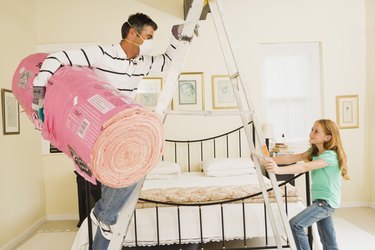Things You'll Need
Fans
Respiratory mask
Latex/rubber gloves
Wire scrub brush
Cold water
Non-ammonia detergent
1 cup bleach
1 gallon water

Mold can be a difficult pest in the home, growing in dark, dank places that are often hard to reach. A mold contamination in your home's insulation can be particularly difficult to deal with as the surface is typically porous and not easy to clean. It is safest to remove and replace moldy insulation whenever possible. However, depending on the size of the contamination and the type of insulation, mold may be kept at bay with thorough disinfecting.
Get Rid of Mold on Porous Insulation
Step 1
Open household windows and doors to ventilate the area. Use fans to circulate the air and dry moist surfaces. Do not use fans if the mold is visible as black or green stains, as it may contain airborne spores, which could spread and further the contamination.
Video of the Day
Step 2
Protect yourself when working with mold by wearing a respiratory mask and rubber/latex gloves.
Step 3
Brush all contaminated, porous insulation, such as fabric or foam, with a wire brush to remove loose mold. Wet insulation should be removed as quickly as possible and allowed to dry. Cardboard, paper, or loose fill insulation should be disposed of, as these will be practically impossible to clean.
Step 4
Remove the insulation entirely from the contaminated area and soak it in cold water.
Step 5
Scrub the contaminated surface, now laid bare by the removed insulation, with a wire scrub brush, detergent, and bleach solution (1 cup bleach and 1 gallon hot water). Allow the solution to sit for at least 10 minutes to thoroughly disinfect.
Step 6
Dry the area completely.
Step 7
Wash the fabric or foam insulation with detergent and bleach solution, once it has soaked for at least 30 minutes, using a machine washer if possible.
Step 8
Allow insulation to dry thoroughly in direct sunlight. Sunlight is a powerful, natural disinfectant.
Step 9
Spray fungicide on the insulation to protect against further mold growth.
Step 10
Re-install insulation.
Get Rid of Mold on Non-Porous Insulation
Step 1
Open household windows and doors to ventilate the area. Use fans to circulate the air if mold has not spread.
Step 2
Protect yourself when working with mold, by wearing a respiratory mask and rubber/latex gloves.
Step 3
Remove the insulation entirely from the contaminated area.
Step 4
Scrape the contaminated non-porous insulation, such as fiberglass or rigid plastic, with a metal scraper to clear it of any loose mold.
Step 5
Scrub the contaminated surface with a wire scrub brush, detergent, and bleach solution (1 cup bleach and 1 gallon hot water). Allow the solution to sit for at least 10 minutes to thoroughly disinfect.
Step 6
Dry the area completely.
Step 7
Douse the insulation in a bleach solution (1 cup bleach and 1 gallon hot water) and scrape clean with a wire brush.
Step 8
Dry thoroughly to prevent future mold growth.
Step 9
Re-install insulation.
Video of the Day